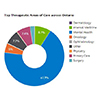About Telemedicine
Using innovative technology, OTN streamlines the health care process, while also expanding the way knowledge is shared and how the medical community interacts with each other and with patients.
Our Bloggers
Categories
More Info
OTN
Blogroll
Top Rated
Blog Posts in the Category: Telemedicine
Written by Ed Brown
on June 5, 2015
There are some incredible innovators and leaders among Ontario’s healthcare community who have advanced the use of telemedicine in the province. We wanted to take a moment to give them some well-deserved recognition.
The Champions of Telemedicine Award was established to celebrate the outstanding contributions of these leaders within each of the 14 Ontario LHINs, and a leader within Ontario’s aboriginal community. OTN’s front-line staff and community partners nominated individuals for this award, and then Champions were selected based on their achievements in the following areas:
Demonstrates leadership among peers and inspires the adoption of telemedicine in their practice, hospital, program or community to help... | |
Comments
Written by Ed Brown
on December 5, 2014
What a year it’s been for Ontario Telemedicine Network (OTN)!
With all the hard work, dedication and passion our partners and employees have devoted to delivering innovative telemedicine solutions, it comes to no surprise that telemedicine continues to grow both in scope and adoption. Last year alone, OTN supported more than 390,000 patient consultations, working with 1,300 healthcare organizations and more than 8,000 healthcare providers in 1,748 sites across Ontario. As a result, almost 260 million kilometers of patient travel was avoided. That represents nearly 330 trips to the moon and back!
Telemedicine is truly transforming our healthcare system with a new model of care delivery – one that improves access, increases... | |
Written by Ed Brown
on October 27, 2014
 | The rate of change in the digital world is nothing short of dazzling. The way we work, communicate and collaborate continues to evolve with new services and applications being introduced every day.
So it gives me great pleasure to announce the launch of the OTNhub, the new one-stop telemedicine service that delivers enhanced convenience and functionality to Ontario’s healthcare providers.
When the integration of OTN services is fully completed in the near future, the OTNhub will allow Primary Care Providers, Specialty Care Providers (specialists and allied health providers) and Healthcare Organizations to access all services relevant to them with a single sign-in. From... |
Written by Rob Williams
on June 19, 2014
 | Have you and your telemedicine colleagues ever wondered how often you use telemedicine compared to other areas of the province? Or how much telemedicine activity occurred in one LHIN versus another LHIN? Or what kinds of therapeutic areas of care were most popular over OTN’s network?
We’ve revamped the way we present our provincial and LHIN data to include historical information that can be displayed in a series of interactive Google Charts. Here’s a quick overview of what you can see with our new interactive LHIN charts (click to view):
... |
Written by Rob Williams
on January 8, 2014
OTN was established in 1997 with the vision that telemedicine will be a mainstream channel for healthcare delivery and education. There were several barriers initially including startup costs, a compelling business case, a process for scheduling events, paying doctors, and overcoming health care professionals’ (HCP) resistance to using the technologies. A business and operational strategy was developed, always keeping in mind the need to be as easy and convenient to use as face-to-face encounters.
OTN currently has four channels of virtual care:
Elective Virtual Ambulatory Care: Last year OTN supported over 300,000 provider/patient real-time video consultations in over 40 specialty services. The top 5 therapeutic... | |
Written by Rob Williams
on August 27, 2013
As I discussed in my previous post, Telemedicine has a variety of applications. Telemedicine also delivers significant benefits for GPs. For example, Otn.teledermSF is a service that enables a referring doctor to consult quickly with a dermatologist anywhere in Ontario. A photograph of a patient’s skin condition, plus pertinent health information, is sent by the GP or RN at the office for review by the specialist, who assesses the information and provides a treatment plan, generally in less than five days. For the patient, wait time is shortened, costs are reduced and inconvenience is lessened. For the GP, a treatment path... | |
Written by Rob Williams
on August 27, 2013
In my previous post on the ways OTN is linking the healthcare community in Ontario, I reviewed how the Northeast Cancer Centre (NCC) is using virtual care to improve both the patient and physician experience. Here are a few more examples of telemedicine in action:
Neurotrauma follow-up: A patient in a remote community with post-injury epilepsy, cognitive impairments and mobility issues travelled alone every few months to Toronto for follow-up consultations with a neurologist. Anxiety related to travel and the disruption of the patient’s routine interfered with the progress and success of his recovery. When his follow-up appointments with... | |
Written by Rob Williams
on August 27, 2013
Telemedicine, the provision of health care by means of telecommunications and information technology, is a reality in Ontario. In the fiscal year 2012-13, more than 300,000 patients received care through telemedicine, a 51% increase over 2011-12.
From April 1998, when Ontario’s first telemedicine sites launched at Sunnybrook Health Sciences Centre, Timmins and District, Kirkland and District and the then Lady Minto hospitals, OTN has grown to more than 100 sites across the province. Geography has been eliminated as a barrier for many patients in Ontario.
An Introduction to Telemedicine
What telemedicine practitioners who have shared their clinical experiences with me helped me realized is that “telemedicine is not a service -... | |

OTN is an independent, not-for-profit
organization funded by the
Government of Ontario.





